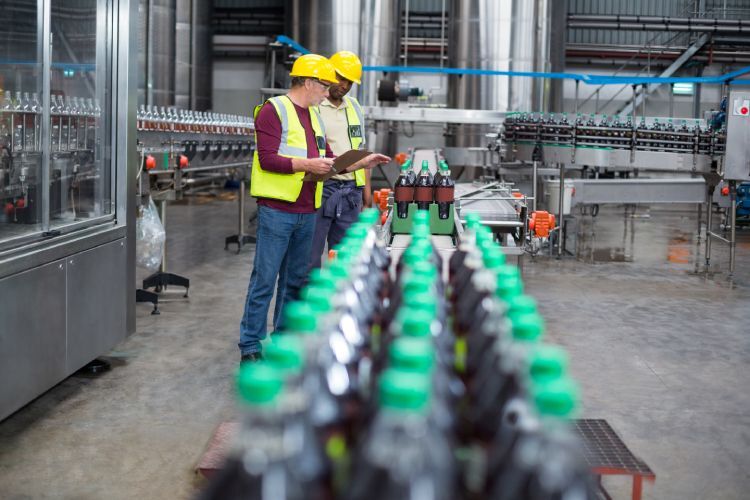 Loading... Please wait...
Loading... Please wait...14 Packaging Machinery Trends: How the Industry Will Change in 2026
Posted on 12th Nov 2025

The packaging industry is shifting fast. Technology is maturing, sustainability is moving from promise to proof, and customers are asking for more variety with less lead time. The common thread: connected machines, actionable data, and people equipped to use both.
By 2026, plants will have to be faster, smarter, cleaner, and easier to reconfigure to stay ahead of industry changes.
Trend #1: Industry 4.0 Becomes the Default
Industry 4.0 is no longer a pilot. In 2026, it’s table stakes. New machines arrive with native connectivity, standardized data tags, and secure remote access. Lines expose real‑time metrics at the machine, cell, and plant level, making it easier to spot bottlenecks and fix them quickly. Instead of siloed programmable logic controllers (PLCs) and proprietary data dumps, you get interoperable systems that speak the same language.
On the floor, that looks like human-machine interfaces (HMIs) that show context, not just alarms. Operators see exactly where a micro‑stop started and what to check first. Engineering leaders benchmark similar lines across sites and copy proven settings with confidence. The payoff is simple but powerful: fewer blind spots, smoother changeovers, and improvements you can replicate.
Strategically, Industry 4.0 turns the packaging line into a source of truth for quality, cost, and throughput. When finance, operations, and quality are looking at the same live data, prioritization gets easier. Capex cases move faster, and so do results.
Trend #2: AI & IoT Are the Line’s Brain & Nervous System
The Internet of Things (IoT) creates the data—vibration, torque, temperature, vision feeds, current draw. Artificial intelligence (AI) turns that data into decisions. By 2026, expect camera models that adapt to new labels with a handful of good examples, anomaly detection on fill curves that flags nozzles before they drift, and reinforcement learning that recommends capper torque settings after a material switch.
For operators, AI is a quiet assistant. It tunes recipes, ranks likely root causes, and points to the next best action. Maintenance teams shift from calendar-based preventative maintenance to model-driven schedules that extend component life without gambling on uptime. Quality managers see fewer escapes and smaller lots quarantined when issues arise.
As your line runs, models get sharper. The more you connect, the more you can predict—and the less you waste.

Trend #3: Data-Driven Strategies Turn Maintenance into a Profit Center
Data-driven strategy means decisions you can audit. In packaging, the fastest path to return on investment (ROI) is predictive maintenance. Sensors surface early signals, like a bearing warming up, a drive pulling extra current, or a screwer requiring more torque variance than normal. Instead of waiting for a breakdown, you plan a short stop, swap a part, and keep the schedule intact.
The business impact is outsized. Planned work costs less than emergency work; uptime stabilizes; crews stop firefighting. Teams start tracking the metrics that matter—overall equipment effectiveness (OEE), mean time between failure (MTBF), changeover time, scrap rate, and energy per unit. With cleaner data, continuous improvement becomes continuous.
By 2026, plants that treat maintenance as a data product—curated, trusted, shared—unlock capacity without buying another machine. That’s a competitive advantage you can measure.
Trend #4: Automation & Cobotics Scale Throughput Without Scaling Headcount
Labor markets stay tight while stock-keeping unit (SKU) counts rise. The answer is targeted automation. Collaborative robots take on repetitive or ergonomically tough tasks like case packing, gentle handling, and late-stage kitting while mobile robots move goods between cells. Operators supervise, intervene on exceptions, and handle higher-value work.
Safety improves alongside output. Collaborative robots (cobots) run at human speed where people are present, then accelerate when the zone is clear. Toolless end‑effector swaps and teach-by-demonstration cut changeover time from hours to minutes. Training shifts toward digital literacy and quick setup skills.
The result is stable throughput, consistent quality, and better retention. People do less strain-inducing work, and lines run more hours with the same team.
Trend #5: Flexible, Modular Machinery Turns the Line into a Platform
Functionality and innovation converge in modular design. Plants need lines that grow and pivot without starting over. In 2026, more equipment ships with plug‑and‑run modules, servo-adjusted guides, and quick-teach vision. Software profiles store fill curves, dwell times, and torque windows, so format changes become a controlled, repeatable process.
Engineering can add capacity with a parallel station instead of replacing a frame. Operations can pilot a new closure or bottle with minimal retooling. Vendors commit to upgrade paths, not just replacements. Your line stops being a single-purpose asset and becomes a platform you can extend.
That agility shows up in profit and loss (P&L) results as shorter time to revenue for new SKUs, fewer long outages for rebuilds, and better asset utilization year-round.

Trend #6: Sustainable Materials Demand Precision & Adaptability
Sustainability commitments and regulations are accelerating the shift to recycled, recyclable, and bio‑based materials. These materials behave differently. Lightweight bottles panel under load; PCR content can vary; labels and adhesives change slip and stretch. Lines that win in 2026 are designed for variability, not perfect spec.
Expect servo-driven handling, adaptive backpressure, and closed‑loop control to maintain fill accuracy and placement across a wider tolerance band. Vision systems verify label edges, cap engagement, and print legibility in real time, even as substrates change. Operators will manage more recipes and verification points, but the reward is big: the ability to accept sustainable specs without sacrificing speed, yield, or shelf appearance.
Trend #7: Energy Efficiency Shifts from Initiative to Line-Level KPI
Energy costs and emissions targets push efficiency into the core key performance indicator (KPI) stack. Spec sheets will include energy per unit alongside cycles per minute. Soft‑start drives, right‑sized motors, vacuum-on‑demand, heat recovery (where relevant), and smart standby modes become common.
When energy data sits next to throughput and scrap data, better decisions follow. Planners can sequence energy‑intensive formats for off‑peak windows. Engineers can quantify savings for every micro‑improvement. Sustainability teams get defensible numbers; finance gets real savings.
If energy is treated like any other constraint to optimize, the line gets greener and cheaper at the same time.
Trend #8: Circular-Economy Design Principles Reframe Machine Requirements
A circular economy keeps materials in play longer. For machinery, that means enabling refill, reuse, and easy recovery. Refill stations and returnable containers require different torque profiles, durability testing, and inspection criteria, so expect growing demand for equipment that handles tethered caps, mono-material components, and labels/inks that don’t contaminate recycling streams.
Packaging engineering will validate performance over multiple cycles and prioritize reclose integrity and tamper evidence that survive reuse. Machines need the finesse to protect finishes and the robustness to handle slightly worn containers without jamming. Lines that can run circular formats unlock new revenue models and brand trust—without sacrificing efficiency.

Trend #9: Supply Chains Are Designed for Resilience, Not Just Cost
Disruptions aren’t a surprise anymore; they’re a variable to plan around. In 2026, resilient lines use standardized components across cells, maintain critical spares on site, and qualify multi‑source options for high-risk parts. Remote diagnostics cut time-to-service dramatically when an issue does arise.
Resilience shows up in engineering standards as much as in procurement. Common drives, common sensors, and common fasteners are choices that simplify maintenance and reduce the odds of a single‑point failure. When demand spikes or a component is delayed, it’s these choices that protect service levels and help you recover quickly.
Trend #10: Disruption-Ready Planning Becomes an Everyday Discipline
Weather events, port congestion, and geopolitical tensions will continue to ripple through packaging. The practical response is disciplined scenario planning. Plants model material substitutions ahead of time, preapprove alternates with quality, and maintain flexible schedules that can absorb a supplier miss without cascading downtime.
On the ground, that looks like faster material approvals, clear run rules for substitutes, and playbooks that define who decides what so that you’re not inventing process during a crisis. And because your line is modular, you can shift formats with less drama.
Trend #11: Trade-Policy Volatility Accelerates Regionalization
Tariffs and shifting trade agreements influence component availability and cost. Many manufacturers are responding with regionalized sourcing and assembly. By 2026, more packaging equipment will be designed around parts with North American or regional availability, shortening lead times and simplifying service logistics.
For capital planning, this approach reduces exposure to sudden policy changes and freight shocks. For after‑sales support, it means faster part deliveries and shorter downtime windows.
When total cost of ownership (TCO) includes policy risk, regionalization often wins on both resilience and economics.

Trend #12: Inflation Pressures Force Precision on Unit Economics
Materials, freight, and skilled labor remain costly. Plants that thrive in 2026 know their unit costs by SKU and by shift and use that clarity to drive projects. Automation that removes scrap and rework does double duty, protecting margins while improving customer experience. Real‑time dashboards make the cost impact of downtime and changeovers visible, so improvements stick.
Governance matters. Tie investments to measurable outcomes, set phase gates, and publish results. When everyone can see the unit‑level math, prioritization gets easier and faster.
Trend #13: Ergonomics & Modern Training Close the Labor Gap
Labor shortages, especially for maintenance and technically minded operators, will persist. The counter is better jobs and better training.
Ergonomic designs reduce strain and injury risk, while digital work instructions, guided setups, and simulation shorten ramp-up time for new hires and make best practices portable across shifts. On the line, that means clearer HMIs, color‑coded change parts, and poka‑yoke fixtures that make the right way the easy way. In the classroom (and on the tablet), it means bite‑sized learning tied to the task at hand.
You keep your people longer. They make fewer mistakes. Everyone wins.
Trend #14: Consumer Demand Reshapes Formats & Speeds Refresh Cycles
Buyers want convenience, clarity, and sustainable choices. That translates into more pack sizes, more formulations, and faster product refresh. Agile lines that change over quickly and verify quality in real time turn variety from a headache into a growth lever.
Expect vision‑guided inspection to check label alignment, print quality, and cap engagement at speed. Closed‑loop controls nudge processes back into spec before waste builds. With modular hardware and recipe‑driven software, seasonal runs and limited editions become practical without capacity penalties.
Plan for 2026 & Beyond with E-PAK Machinery
Readiness is the strategy. Be ready to connect, change formats, and run efficiently despite labor and supply variability. The organizations that win invest in flexible machines, unified data, and people who can operate confidently in a digital environment. They standardize smart, automate where it hurts, and measure what matters.
At E PAK Machinery, we build liquid packaging machines for the future. From fillers and cappers to labelers and full lines, our equipment emphasizes reliability, clean integration, and ease of use so you can adopt these trends without adding complexity.
Contact us today to build a packaging operation that’s ready for 2026 and beyond.
Recent Posts
- Automatic vs. Semi-Automatic Liquid Filling Machines: Which Option Is Right for Your Packaging Line?
- 14 Packaging Machinery Trends: How the Industry Will Change in 2026
- Types of Capping Machines & Their Features: A Complete Guide for Packaging Lines
- Capping Machine Price Guide: What Affects the Cost of Your Capper?
- A Guide to the Liquid Filling Process: Methods, Key Aspects, & More
